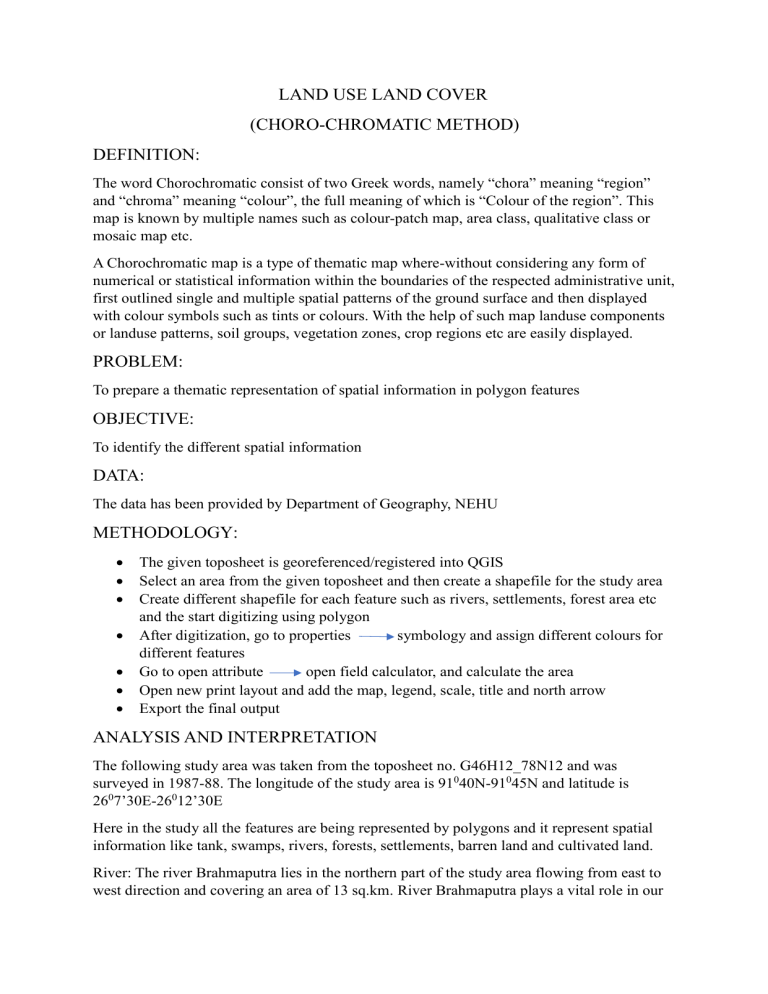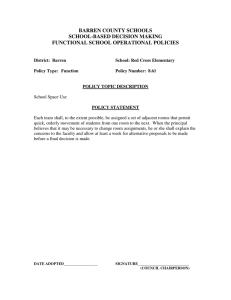
LAND USE LAND COVER (CHORO-CHROMATIC METHOD) DEFINITION: The word Chorochromatic consist of two Greek words, namely “chora” meaning “region” and “chroma” meaning “colour”, the full meaning of which is “Colour of the region”. This map is known by multiple names such as colour-patch map, area class, qualitative class or mosaic map etc. A Chorochromatic map is a type of thematic map where-without considering any form of numerical or statistical information within the boundaries of the respected administrative unit, first outlined single and multiple spatial patterns of the ground surface and then displayed with colour symbols such as tints or colours. With the help of such map landuse components or landuse patterns, soil groups, vegetation zones, crop regions etc are easily displayed. PROBLEM: To prepare a thematic representation of spatial information in polygon features OBJECTIVE: To identify the different spatial information DATA: The data has been provided by Department of Geography, NEHU METHODOLOGY: The given toposheet is georeferenced/registered into QGIS Select an area from the given toposheet and then create a shapefile for the study area Create different shapefile for each feature such as rivers, settlements, forest area etc and the start digitizing using polygon After digitization, go to properties symbology and assign different colours for different features Go to open attribute open field calculator, and calculate the area Open new print layout and add the map, legend, scale, title and north arrow Export the final output ANALYSIS AND INTERPRETATION The following study area was taken from the toposheet no. G46H12_78N12 and was surveyed in 1987-88. The longitude of the study area is 91040N-91045N and latitude is 2607’30E-26012’30E Here in the study all the features are being represented by polygons and it represent spatial information like tank, swamps, rivers, forests, settlements, barren land and cultivated land. River: The river Brahmaputra lies in the northern part of the study area flowing from east to west direction and covering an area of 13 sq.km. River Brahmaputra plays a vital role in our ecosystem and provide numerous benefits to both humans and the environment such as fresh water supply, transportation, water for irrigations, bio-diversity and many more. Settlement: settlements are mostly located in and around the river bank and covers roughly 30sq.km. The settlement are located near river because it provides a consistent and easily accessible water resource for human settlement and agriculture. River also provides natural resources such as fish, freshwater for drinking and energy potential through hydropower generation. It also serves as an important transport routes. Settlement near river has easy access to water-based transportation allowing people to transport goods and engage in trade with other communities. Cultivated land: River often has floodplains adjacent to their banks. These floodplains received periodic floods which deposit rich nutrient sediments, farmers take advantage of these and practice agriculture. Cultivating crops near river can lead to higher agricultural productivity and better yield. Floodplains near Brahmaputra are one of the most fertile lands. Forests: The reserved forests can be found in the northwestern and the southern part of the study area covering an area of about 12sq.km. The forest is incredibly valuable ecosystem that offer wide range of benefits such as biodiversity conservation, recreational and tourism, carbon sink and many more. Wet Land: The wetland, covering a total area of 5sq.km can be found in the northern, western and some patches can be found in the eastern side of the study area, typically in low-lying areas with high water content dominated by trees, shrubs and other vegetations. Wetland despite their challenging and inhospitable conditions provide numerous benefits such as storing of carbon, ground water recharge zone and water filtration, flood control etc. Tank: The tanks is found in the northern and western part of study are. They formed by rivers or groundwater and serves as water supply, irrigation, flood control, biodiversity and ecosystem support and many more Barren Land: The Barren land can be seen in the eastern and southern parts of the study area, covering an area of 4sq.km. It is characterized by low-growing scrubs, occurs in arid or semi-arid climate where the availability of water is limited. CONCLUSION: The chorochromatic map, through its different shades of colours enable the representation of different spatial information/phenomena and its relationship. By employing chorochromatic map we can organize and analyse data in a structured and meaningful way, enabling better decision making and understanding of the area around us



